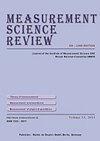ISO线性校准及校准仪器测量结果的不确定度
IF 0.8
4区 工程技术
Q4 INSTRUMENTS & INSTRUMENTATION
引用次数: 0
摘要
摘要:本文讨论了线性比较校准问题,这是线性校准中两个变量都有误差的特殊情况,并分析了校准仪器测量结果的不确定度。通过对压力传感器的标定实验和测量不确定度的分析,详细阐述了该概念。在这种情况下,校准和校准仪器的测量是根据ISO技术规范28037:2010(这里称为ISO线性校准)进行的,基于近似线性校准模型和不确定性传播定律(LPU)在该近似模型中的应用。或者,利用基于分布传播定律(LPD)的蒙特卡罗方法(MCM)获得校准线参数、其标准不确定性、覆盖区间和相关概率分布的估计。在这里,我们还得到了校准仪器测量量的概率分布和覆盖区间。此外,基于该模型结构,我们进行了模拟研究,给出了ISO和MCM覆盖区间的经验覆盖概率,并研究了样本量(即测量范围内校准点的数量)和测量不确定度的不同组合的影响。该研究总体上证实了ISO技术规范在考虑(有限)的实验设计框架内的良好性能和有效性,这些实验设计是由实际应用驱动的,与测量范围有关的不确定性很小。我们还指出了这种方法的潜在弱点,需要增加用户的注意,并强调需要在这一领域进一步研究。本文章由计算机程序翻译,如有差异,请以英文原文为准。
ISO Linear Calibration and Measurement Uncertainty of the Result Obtained With the Calibrated Instrument
Abstract We address the problem of linear comparative calibration, a special case of linear calibration where both variables are measured with errors, and the analysis of the uncertainty of the measurement results obtained with the calibrated instrument. The concept is explained in detail using the calibration experiment of the pressure transducer and the subsequent analysis of the measurement uncertainties. In this context, the calibration and the measurements with the calibrated instrument are performed according to ISO Technical Specification 28037:2010 (here referred to as ISO linear calibration), based on the approximate linear calibration model and the application of the law of propagation of uncertainty (LPU) in this approximate model. Alternatively, estimates of the calibration line parameters, their standard uncertainties, the coverage intervals and the associated probability distributions are obtained using the Monte Carlo method (MCM) based on the law of propagation of distributions (LPD). Here we also obtain the probability distributions and the coverage interval for the quantities measured with the calibrated instrument. Furthermore, motivated by the model structure of this particular example, we conducted a simulation study that presents the empirical coverage probabilities of the ISO and MCM coverage intervals and investigates the influence of the sample size, i.e. the number of calibration points in the measurement range, and the different combinations of measurement uncertainties. The study generally confirms the good properties and validity of the ISO technical specification within the considered (limited) framework of experimental designs motivated by real-world application, with small uncertainties in relation to the measurement range. We also point out the potential weaknesses of this method that require increased user attention and emphasise the need for further research in this area.
求助全文
通过发布文献求助,成功后即可免费获取论文全文。
去求助
来源期刊

Measurement Science Review
INSTRUMENTS & INSTRUMENTATION-
CiteScore
2.00
自引率
11.10%
发文量
37
审稿时长
4.8 months
期刊介绍:
- theory of measurement - mathematical processing of measured data - measurement uncertainty minimisation - statistical methods in data evaluation and modelling - measurement as an interdisciplinary activity - measurement science in education - medical imaging methods, image processing - biosignal measurement, processing and analysis - model based biomeasurements - neural networks in biomeasurement - telemeasurement in biomedicine - measurement in nanomedicine - measurement of basic physical quantities - magnetic and electric fields measurements - measurement of geometrical and mechanical quantities - optical measuring methods - electromagnetic compatibility - measurement in material science
 求助内容:
求助内容: 应助结果提醒方式:
应助结果提醒方式:


